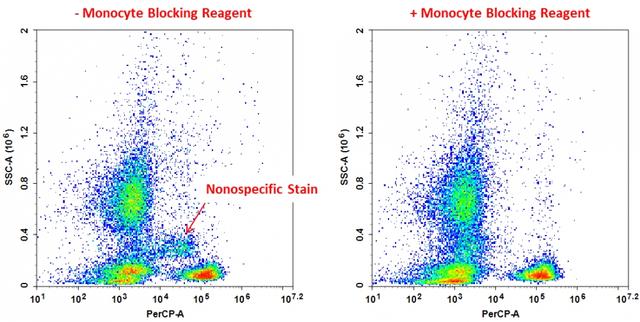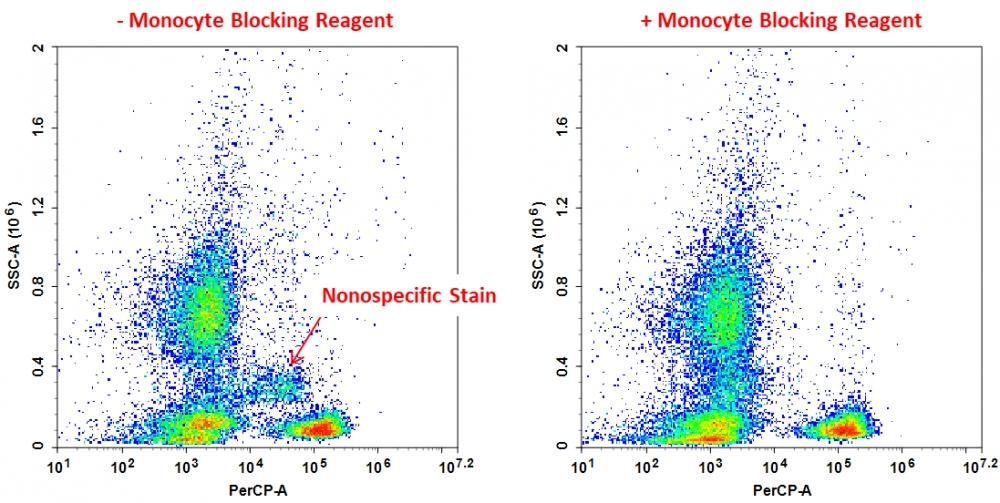CytoWatch™ QZ100 Monocyte Blocking Reagent
Ordering information
| Price | |
| Catalog Number | |
| Unit Size | |
| Quantity |
Additional ordering information
| Telephone | 1-800-990-8053 |
| Fax | 1-800-609-2943 |
| sales@aatbio.com | |
| International | See distributors |
| Bulk request | Inquire |
| Custom size | Inquire |
| Shipping | Standard overnight for United States, inquire for international |
Physical properties
| Solvent | PBS |
Storage, safety and handling
| H-phrase | H303, H313, H333 |
| Hazard symbol | XN |
| Intended use | Research Use Only (RUO) |
| R-phrase | R20, R21, R22 |
| Storage | Refrigerated (2-8 °C) |
| UNSPSC | 12171501 |
| Overview |
See also: Buffers and Lab Consumables
CAS N/A |
Some dye-labeled fluorescent antibody conjugates used in cell surface staining of live cells often exhibit non-specific binding in monocytes and macrophages. CytoWatch™ QZ100 Monocyte Blocking Reagent is a non-antibody-based blocking solution that is optimized to blocking the non-specific background of cyanine-based dye conjugates. It can effectively eliminate non-specific staining of monocytes and macrophages by cyanine dye conjugates (such as PE/Cy5, PE/Cy7, APC/Cy7, PE/Dazzle™ 594, APC/Fire™ 750, PE/Alexa Fluor® 647, PE/Alexa Fluor® 750, APC/Alexa Fluor® 750, PE/iFluor® 647, PE/iFluor® 750 and APC/iFluor® 750). The reagent has no impact on the specific surface staining of live lymphocytes, monocytes, and granulocytes.
Example protocol
SAMPLE EXPERIMENTAL PROTOCOL
Cell Surface Staining Protocol for Flow Cytometry Analysis
- Add 5 µL of CytoWatch™ QZ100 Monocyte Blocking Reagent to 100 µL of PBMC or whole blood.
- Incubate for 5-10 minutes at room temperature or add primary antibodies immediately, and incubate at room temperature for 20 minutes.
- Wash twice with cell staining buffer.
- Resuspend cells in 0.5 mL of cell staining buffer.
- Perform flow cytometric analysis.
Images
References
View all 50 references: Citation Explorer
Synergistic reduction in albuminuria in type 2 diabetic mice by esaxerenone (CS-3150), a novel nonsteroidal selective mineralocorticoid receptor blocker, combined with an angiotensin II receptor blocker.
Authors: Arai, Kiyoshi and Morikawa, Yuka and Ubukata, Naoko and Sugimoto, Kotaro
Journal: Hypertension research : official journal of the Japanese Society of Hypertension (2020): 1204-1213
Authors: Arai, Kiyoshi and Morikawa, Yuka and Ubukata, Naoko and Sugimoto, Kotaro
Journal: Hypertension research : official journal of the Japanese Society of Hypertension (2020): 1204-1213
Prior β-blocker treatment decreases leukocyte responsiveness to injury.
Authors: Grisanti, Laurel A and de Lucia, Claudio and Thomas, Toby P and Stark, Aron and Strony, John T and Myers, Valerie D and Beretta, Remus and Yu, Daohai and Sardu, Celestino and Marfella, Raffaele and Gao, Erhe and Houser, Steven R and Koch, Walter J and Hamad, Eman A and Tilley, Douglas G
Journal: JCI insight (2019)
Authors: Grisanti, Laurel A and de Lucia, Claudio and Thomas, Toby P and Stark, Aron and Strony, John T and Myers, Valerie D and Beretta, Remus and Yu, Daohai and Sardu, Celestino and Marfella, Raffaele and Gao, Erhe and Houser, Steven R and Koch, Walter J and Hamad, Eman A and Tilley, Douglas G
Journal: JCI insight (2019)
The Angiotensin Receptor Blocker Losartan Suppresses Growth of Pulmonary Metastases via AT1R-Independent Inhibition of CCR2 Signaling and Monocyte Recruitment.
Authors: Regan, Daniel P and Coy, Jonathan W and Chahal, Kirti Kandhwal and Chow, Lyndah and Kurihara, Jade N and Guth, Amanda M and Kufareva, Irina and Dow, Steven W
Journal: Journal of immunology (Baltimore, Md. : 1950) (2019): 3087-3102
Authors: Regan, Daniel P and Coy, Jonathan W and Chahal, Kirti Kandhwal and Chow, Lyndah and Kurihara, Jade N and Guth, Amanda M and Kufareva, Irina and Dow, Steven W
Journal: Journal of immunology (Baltimore, Md. : 1950) (2019): 3087-3102
Neprilysin Inhibitor-Angiotensin II Receptor Blocker Combination Therapy (Sacubitril/valsartan) Suppresses Atherosclerotic Plaque Formation and Inhibits Inflammation in Apolipoprotein E- Deficient Mice.
Authors: Zhang, Hui and Liu, Gangqiong and Zhou, Wenping and Zhang, Wenjing and Wang, Kai and Zhang, Jinying
Journal: Scientific reports (2019): 6509
Authors: Zhang, Hui and Liu, Gangqiong and Zhou, Wenping and Zhang, Wenjing and Wang, Kai and Zhang, Jinying
Journal: Scientific reports (2019): 6509
Angiotensin II type 1 receptor blocker telmisartan induces apoptosis and autophagy in adult T-cell leukemia cells.
Authors: Kozako, Tomohiro and Soeda, Shuhei and Yoshimitsu, Makoto and Arima, Naomichi and Kuroki, Ayako and Hirata, Shinya and Tanaka, Hiroaki and Imakyure, Osamu and Tone, Nanako and Honda, Shin-Ichiro and Soeda, Shinji
Journal: FEBS open bio (2016): 442-60
Authors: Kozako, Tomohiro and Soeda, Shuhei and Yoshimitsu, Makoto and Arima, Naomichi and Kuroki, Ayako and Hirata, Shinya and Tanaka, Hiroaki and Imakyure, Osamu and Tone, Nanako and Honda, Shin-Ichiro and Soeda, Shinji
Journal: FEBS open bio (2016): 442-60
The TLR-2/TLR-6 agonist macrophage-activating lipopeptide-2 augments human NK cell cytotoxicity when PGE2 production by monocytes is inhibited by a COX-2 blocker.
Authors: Müller, Christina and Tufa, Dejene M and Chatterjee, Debanjana and Mühlradt, Peter F and Schmidt, Reinhold E and Jacobs, Roland
Journal: Cancer immunology, immunotherapy : CII (2015): 1175-84
Authors: Müller, Christina and Tufa, Dejene M and Chatterjee, Debanjana and Mühlradt, Peter F and Schmidt, Reinhold E and Jacobs, Roland
Journal: Cancer immunology, immunotherapy : CII (2015): 1175-84
Renoprotective effects of angiotensin receptor blocker and stem cells in acute kidney injury: Involvement of inflammatory and apoptotic markers.
Authors: Sherif, Iman O and Al-Mutabagani, Laila A and Alnakhli, Anwar M and Sobh, Mohamed A and Mohammed, Hoda E
Journal: Experimental biology and medicine (Maywood, N.J.) (2015): 1572-9
Authors: Sherif, Iman O and Al-Mutabagani, Laila A and Alnakhli, Anwar M and Sobh, Mohamed A and Mohammed, Hoda E
Journal: Experimental biology and medicine (Maywood, N.J.) (2015): 1572-9
Macrophage CD14 expression in human carotid plaques is associated with complicated lesions, correlates with thrombosis, and is reduced by angiotensin receptor blocker treatment.
Authors: Hermansson, Cecilia and Lundqvist, Annika and Magnusson, Lisa U and Ullström, Christina and Bergström, Göran and Hultén, Lillemor Mattsson
Journal: International immunopharmacology (2014): 318-23
Authors: Hermansson, Cecilia and Lundqvist, Annika and Magnusson, Lisa U and Ullström, Christina and Bergström, Göran and Hultén, Lillemor Mattsson
Journal: International immunopharmacology (2014): 318-23
Azilsartan, an angiotensin II type 1 receptor blocker, restores endothelial function by reducing vascular inflammation and by increasing the phosphorylation ratio Ser(1177)/Thr(497) of endothelial nitric oxide synthase in diabetic mice.
Authors: Matsumoto, Sachiko and Shimabukuro, Michio and Fukuda, Daiju and Soeki, Takeshi and Yamakawa, Ken and Masuzaki, Hiroaki and Sata, Masataka
Journal: Cardiovascular diabetology (2014): 30
Authors: Matsumoto, Sachiko and Shimabukuro, Michio and Fukuda, Daiju and Soeki, Takeshi and Yamakawa, Ken and Masuzaki, Hiroaki and Sata, Masataka
Journal: Cardiovascular diabetology (2014): 30
Platelet activation in essential hypertension during exercise: pre- and post-treatment changes with an angiotensin II receptor blocker.
Authors: Gkaliagkousi, Eugenia and Gavriilaki, Eleni and Yiannaki, Efi and Markala, Dimitra and Papadopoulos, Nikolaos and Triantafyllou, Areti and Anyfanti, Panagiota and Petidis, Konstantinos and Garypidou, Vasileia and Doumas, Michael and Ferro, Albert and Douma, Stella
Journal: American journal of hypertension (2014): 571-8
Authors: Gkaliagkousi, Eugenia and Gavriilaki, Eleni and Yiannaki, Efi and Markala, Dimitra and Papadopoulos, Nikolaos and Triantafyllou, Areti and Anyfanti, Panagiota and Petidis, Konstantinos and Garypidou, Vasileia and Doumas, Michael and Ferro, Albert and Douma, Stella
Journal: American journal of hypertension (2014): 571-8
Application notes
FAQ
How can I lyse my cells without lysing the nuclear membrane?
What is the difference between FluoroQuest Anti-fading Kit I and FluoroQuest Anti-fading Kit II?
What does an assay buffer do?
How to lyse cells?
Why is my GSH concentration greater than my Total GSH concentration? Why is my calculated GSH/TGSH ratio greater than 1?
What is the difference between FluoroQuest Anti-fading Kit I and FluoroQuest Anti-fading Kit II?
What does an assay buffer do?
How to lyse cells?
Why is my GSH concentration greater than my Total GSH concentration? Why is my calculated GSH/TGSH ratio greater than 1?


